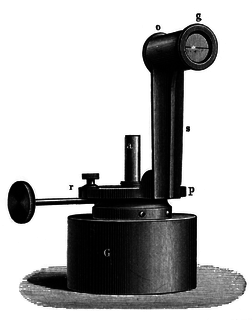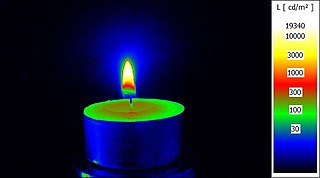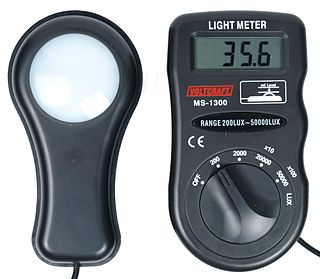 W
WPhotometry is the science of the measurement of light, in terms of its perceived brightness to the human eye. It is distinct from radiometry, which is the science of measurement of radiant energy in terms of absolute power. In modern photometry, the radiant power at each wavelength is weighted by a luminosity function that models human brightness sensitivity. Typically, this weighting function is the photopic sensitivity function, although the scotopic function or other functions may also be applied in the same way.
 W
WBrightness is an attribute of visual perception in which a source appears to be radiating or reflecting light. In other words, brightness is the perception elicited by the luminance of a visual target. The perception is not linear to luminance, and relies on the context of the viewing environment.
 W
WIn photography, exposure value (EV) is a number that represents a combination of a camera's shutter speed and f-number, such that all combinations that yield the same exposure have the same EV. Exposure value is also used to indicate an interval on the photographic exposure scale, with a difference of 1 EV corresponding to a standard power-of-2 exposure step, commonly referred to as a stop.
 W
WIn photography, exposure value (EV) is a number that represents a combination of a camera's shutter speed and f-number, such that all combinations that yield the same exposure have the same EV. Exposure value is also used to indicate an interval on the photographic exposure scale, with a difference of 1 EV corresponding to a standard power-of-2 exposure step, commonly referred to as a stop.
 W
WThe Carcel lamp was an efficient lighting device used in the nineteenth century for domestic purposes and in France as the standard measure for illumination.
 W
WChromaticity is an objective specification of the quality of a color regardless of its luminance. Chromaticity consists of two independent parameters, often specified as hue (h) and colorfulness (s), where the latter is alternatively called saturation, chroma, intensity, or excitation purity. This number of parameters follows from trichromacy of vision of most humans, which is assumed by most models in color science.
 W
WA color space is a specific organization of colors. In combination with color profiling supported by various physical devices, it supports reproducible representations of color -- whether such representation entails an analog or a digital representation. A color space may be arbitrary, i.e. with physically realized colors assigned to a set of physical color swatches with corresponding assigned color names, or structured with mathematical rigor. A "color space" is a useful conceptual tool for understanding the color capabilities of a particular device or digital file. When trying to reproduce color on another device, color spaces can show whether you will be able to retain shadow/highlight detail, color saturation, and by how much either will be compromised.
 W
WContrast is the difference in luminance or colour that makes an object distinguishable. In visual perception of the real world, contrast is determined by the difference in the colour and brightness of the object and other objects within the same field of view. The human visual system is more sensitive to contrast than absolute luminance; we can perceive the world similarly regardless of the huge changes in illumination over the day or from place to place. The maximum contrast of an image is the contrast ratio or dynamic range.
 W
WEULUMDAT is a data file format used for specification of photometric data especially intensity distributions from light sources such as lamps and luminaries. The file extension is .ldt. The format was proposed by Axel Stockmar in 1990. The format is the European equivalent to the IES file format specified in IESNA LM-63. The data in an EULUMDAT file is usually measured using a goniophotometer. The IES file format is more formally specified and many measuring instruments support both formats of file.
 W
WIn photography, exposure value (EV) is a number that represents a combination of a camera's shutter speed and f-number, such that all combinations that yield the same exposure have the same EV. Exposure value is also used to indicate an interval on the photographic exposure scale, with a difference of 1 EV corresponding to a standard power-of-2 exposure step, commonly referred to as a stop.
 W
WA Goniophotometer is a device used for measurement of the light emitted from an object at different angles. The use of goniophotometers has been increasing in recent years with the introduction of LED-light sources, which are mostly directed light sources, where the spatial distribution of light is not homogeneous. If a light source is homogeneous in its distribution of light, it is called a Lambertian source. Due to strict regulations, the spatial distribution of light is of high importance to automotive lighting and its design.
 W
WA gonioreflectometer is a device for measuring a bidirectional reflectance distribution function (BRDF).
 W
WA gray card is a middle gray reference, typically used together with a reflective light meter, as a way to produce consistent image exposure and/or color in video production, film and photography.
 W
WThe Hefner lamp, or in German Hefnerkerze, is a flame lamp used in photometry that burns amyl acetate.
 W
WIn photometry, illuminance is the total luminous flux incident on a surface, per unit area. It is a measure of how much the incident light illuminates the surface, wavelength-weighted by the luminosity function to correlate with human brightness perception. Similarly, luminous emittance is the luminous flux per unit area emitted from a surface. Luminous emittance is also known as luminous exitance.
 W
WAn integrating sphere is an optical component consisting of a hollow spherical cavity with its interior covered with a diffuse white reflective coating, with small holes for entrance and exit ports. Its relevant property is a uniform scattering or diffusing effect. Light rays incident on any point on the inner surface are, by multiple scattering reflections, distributed equally to all other points. The effects of the original direction of light are minimized. An integrating sphere may be thought of as a diffuser which preserves power but destroys spatial information. It is typically used with some light source and a detector for optical power measurement. A similar device is the focusing or Coblentz sphere, which differs in that it has a mirror-like (specular) inner surface rather than a diffuse inner surface.
 W
WCandlepower is a unit of measurement for luminous intensity. It expresses levels of light intensity relative to the light emitted by a candle of specific size and constituents. The historical candlepower is equal to 1.02 candelas. In modern usage, candlepower is sometimes used as a synonym for candela.
 W
WLightness is a visual perception of the luminance of an object. It is often judged relative to a similarly lit object. In colorimetry and color appearance models, lightness is a prediction of how an illuminated color will appear to a standard observer. While luminance is a linear measurement of light, lightness is a linear prediction of the human perception of that light.
 W
WLuminance is a photometric measure of the luminous intensity per unit area of light travelling in a given direction. It describes the amount of light that passes through, is emitted from, or is reflected from a particular area, and falls within a given solid angle.
 W
WA luminous efficiency function or luminosity function represents the average spectral sensitivity of human visual perception of light. It is based on subjective judgements of which of a pair of different-colored lights is brighter, to describe relative sensitivity to light of different wavelengths. It is not an absolute reference to any particular individual, but is a standard observer representation of visual sensitivity of theoretical human eye. It is valuable as a baseline for experimental purposes, and in colorimetry. Different luminous efficiency functions apply under different lighting conditions, varying from photopic in brightly lit conditions through mesotopic to scotopic under low lighting conditions. When not specified, the luminous efficiency function generally refers to the photopic luminous efficiency function.
 W
WIn photography, exposure is the amount of light per unit area reaching a frame of photographic film or the surface of an electronic image sensor, as determined by shutter speed, lens aperture, and scene luminance. Exposure is measured in lux seconds, and can be computed from exposure value (EV) and scene luminance in a specified region.
 W
WIn photometry, luminous flux or luminous power is the measure of the perceived power of light. It differs from radiant flux, the measure of the total power of electromagnetic radiation, in that luminous flux is adjusted to reflect the varying sensitivity of the human eye to different wavelengths of light.
 W
WIn photometry, luminous intensity is a measure of the wavelength-weighted power emitted by a light source in a particular direction per unit solid angle, based on the luminosity function, a standardized model of the sensitivity of the human eye. The SI unit of luminous intensity is the candela (cd), an SI base unit.
 W
WA photometer is an instrument that measures the strength of electromagnetic radiation in the range from ultraviolet to infrared and including the visible spectrum. Most photometers convert light into an electric current using a photoresistor, photodiode, or photomultiplier.
 W
WIn photography, exposure is the amount of light per unit area reaching a frame of photographic film or the surface of an electronic image sensor, as determined by shutter speed, lens aperture, and scene luminance. Exposure is measured in lux seconds, and can be computed from exposure value (EV) and scene luminance in a specified region.
 W
WRight to light is a form of easement in English law that gives a long-standing owner of a building with windows a right to maintain an adequate level of illumination. The right was traditionally known as the doctrine of "ancient lights". It is also possible for a right to light to exist if granted expressly by deed, or granted implicitly, for example under the rule in Wheeldon v. Burrows (1879).
 W
WVeiling glare is an imperfection of performance in optical instruments arising from incoming light that strays from the normal image-forming paths, and reaches the focal plane. The effect superimposes a form of noise onto the normal image sensed by the detector, resulting in a final image degraded by loss of contrast and reduced definition.